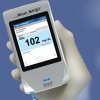Nova Biomedical (Waltham, MA) won FDA clearance for its StatStrip Glucose Hospital Meter System, an accurate clinical level device for use anywhere from the neonatal ward to the intensive care unit. It is the first FDA-cleared device that has been cleared for blood sugar metering and management in all professional healthcare settings.
The device measures hematocrit, the volume percentage of red blood cells that can affect glucose readings, and automatically corrects to provide an accurate result. Additionally, the device also adjusts for any electrochemical interference, including acetaminophen, ascorbic acid, and maltose, that may skew the results and adjusts to compensate for those as well.
Details of the study that led to the clearance according to the press release:
The announcement comes after an extensive, four-year project with the FDA and five prestigious university medical centers. It represents a landmark clinical breakthrough in improved patient care and safety.
Because of the unacceptably high rate of adverse patient events, including deaths, linked to the point-of-care (POC) use of glucose meters within hospitals, the FDA recognized the need for more accuracy and better performance standards for POC glucose testing in hospitals, particularly in intensive care settings. Nova recognized this need in 2010 and met with the FDA to define the rigorous studies necessary to clear StatStrip Glucose for use throughout all patient populations and all hospital settings. Studies included extensive evaluations in intensive and critical care settings with patients receiving intensive medical intervention/therapy.
glucose errors Nova StatStrip, a Hematocrit and Electrochemical Interference Correcting Clinical Glucometer, FDA ClearedThe StatStrip Glucose performance comparative evaluation submitted to the FDA included 1,698 patients receiving intensive medical intervention and 1,815 data points. It included data from five university medical centers in multiple clinical intensive care settings. All of these whole blood glucose measurements were compared to plasma central laboratory IDMS traceable methods. The patient data included 19 medical condition categories as designated by the World Health Organization, representing 257 different medical condition sub-categories, in which approximately 8,000 medications were administered to patients. These complex drug regimens represent 33 parent drug classes as designated by the United States Pharmacopeia and 144 subclasses of medications. For each major medical condition and drug class category, StatStrip Glucose was evaluated against several rigorous performance criteria, statistical analyses tools, and insulin dosing error risk assessment models used by medical professionals, standards organizations, and regulators.
All of the performance assessment tools, including the insulin dosing risk models, demonstrated that StatStrip Glucose has acceptable clinical performance within intensive care settings when testing is performed by healthcare professionals or POC waived operators. More importantly, StatStrip Glucose demonstrated substantial equivalence to central laboratory IDMS traceable reference methods, when used with patients receiving intensive medical intervention/therapy.
In addition to the extensive FDA evaluation, over additional 136 independent studies—including 53 intensive care settings—have found no clinical interferences for StatStrip Glucose. It is the world’s most extensively studied and best understood glucose test. After seven years of extensive studies and significant field use, StatStrip Glucose is now cleared by the FDA to be safe and effective for use with all patients in all professional healthcare settings including intensive care and critical care settings.
source:Nova Biomedical
Nova StatStrip, a Hematocrit and Electrochemical Interference Correcting Clinical Glucometer

